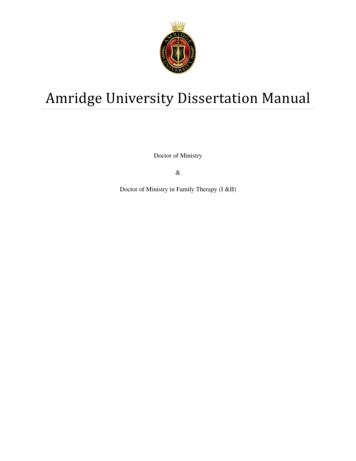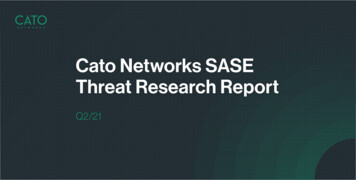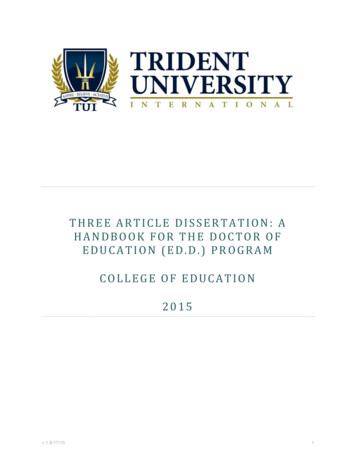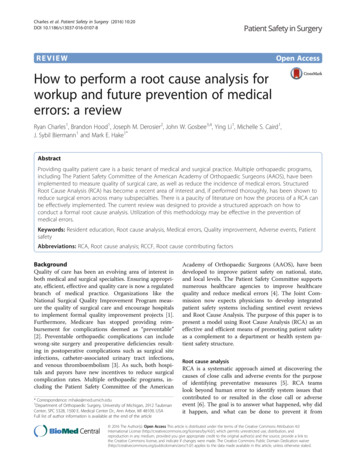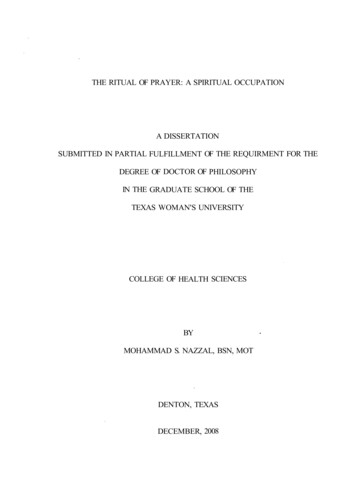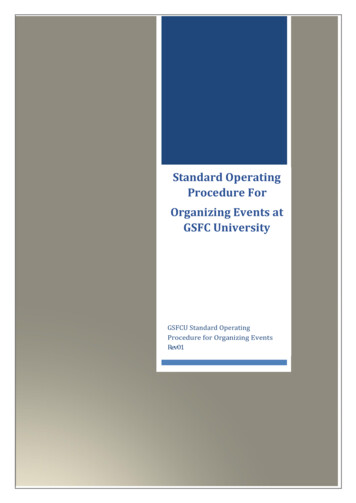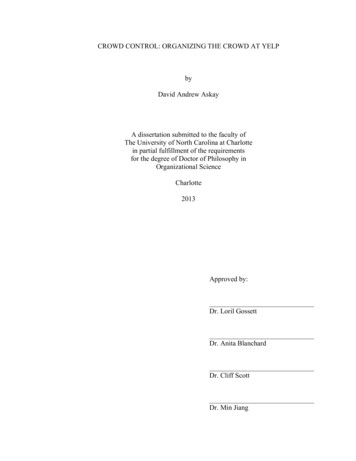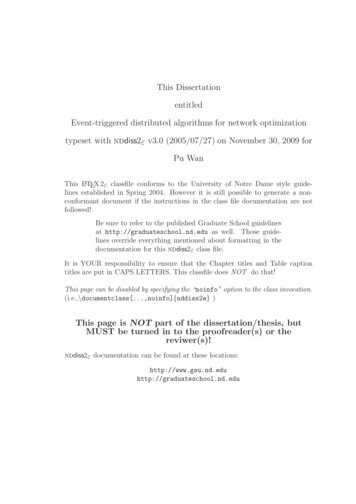
Transcription
This DissertationentitledEvent-triggered distributed algorithms for network optimizationtypeset with nddiss2ε v3.0 (2005/07/27) on November 30, 2009 forPu WanThis LATEX 2ε classfile conforms to the University of Notre Dame style guidelines established in Spring 2004. However it is still possible to generate a nonconformant document if the instructions in the class file documentation are notfollowed!Be sure to refer to the published Graduate School guidelinesat http://graduateschool.nd.edu as well. Those guidelines override everything mentioned about formatting in thedocumentation for this nddiss2ε class file.It is YOUR responsibility to ensure that the Chapter titles and Table captiontitles are put in CAPS LETTERS. This classfile does NOT do that!This page can be disabled by specifying the “noinfo” option to the class } )This page is NOT part of the dissertation/thesis, butMUST be turned in to the proofreader(s) or thereviwer(s)!nddiss2ε documentation can be found at these ol.nd.edu
Event-triggered distributed algorithms for network optimizationA DissertationSubmitted to the Graduate Schoolof the University of Notre Damein Partial Fulfillment of the Requirementsfor the Degree ofDoctor of Philosophy in Electrical EngineeringbyPu Wan, M.S. in Electrical EngineeringMichael D. Lemmon, DirectorGraduate Program in Department of Electrical EngineeringNotre Dame, IndianaNovember 2009
Event-triggered distributed algorithms for network optimizationAbstractbyPu WanMany existing distributed algorithms for network optimization problems often rely on the fact that, if the communications between subsystems are frequentenough, then the state of the network will converge to its optimum asymptotically.This approach will generally incur large communication cost. This work investigates the use of event-triggered communication schemes in distributed networkoptimization algorithms. Under event triggering, each subsystem broadcasts toits neighbors when a local “error” signal exceeds a state dependent threshold. Weuse the network utility maximization (NUM) problem as an example to demonstrate our idea.We first present an event-triggered distributed barrier algorithm and proveits convergence. The algorithm shows significant reduction in the communicationcost of the network. However, the algorithm suffers from several issues whichlimit its usefulness. We then propose two different event-triggered distributedNUM algorithms, the primal, and the primal-dual algorithm. Both algorithmsare based on the augmented Lagrangian methods. We establish state-dependentevent-triggering thresholds under which the proposed algorithms converge to thesolution of NUM. For the primal-dual algorithm, we consider scenarios when thenetwork has data dropouts or transmission delay, and give an upper bound on the
Pu Wanlargest number of successive data dropouts and the maximum allowable transmission delay, while ensuring the asymptotic convergence of the algorithm. Astate-dependent lower bound on the broadcast period is also given. Simulationsshow that all proposed algorithms reduce the number of message exchanges byup to two orders of magnitude when compared to existing dual decompositionalgorithms, and are scale-free with respect to two measures of network size.We then use the optimal power flow (OPF) problem in microgrids as a nontrivial real-life example to demonstrate the effectiveness of event-triggered optimization algorithms. We develop an event-triggered distributed algorithm for theOPF problem and prove its convergence. We use the CERTS microgrid model asan example power system to show the effectiveness of our algorithm. The simulation is done in MATLAB/SimPower and shows that our algorithm solves theOPF problem in a distributed way, and the communication between neighboringsubsystems is very infrequent.
CONTENTSFIGURES . . . . . . . . . . . . . . . . . . . . . . . . . . . . . . . . . . . .ivTABLESvi. . . . . . . . . . . . . . . . . . . . . . . . . . . . . . . . . . . .CHAPTER 1: Introduction . . . . . . . . . . . . . . . . . .1.1 Motivation . . . . . . . . . . . . . . . . . . . . . . .1.2 The Network Utility Maximization (NUM) problem1.3 Prior work: Distributed algorithms for NUM . . . .1.3.1 Kelly’s Initial Work . . . . . . . . . . . . . .1.3.2 Dual decomposition approach . . . . . . . .1.3.3 Passivity Approach . . . . . . . . . . . . . .1.4 Prior work: Event-triggered control . . . . . . . . .1.5 Outline of thesis . . . . . . . . . . . . . . . . . . . .CHAPTER 2: Event-triggered distributed optimization using barrier methods2.1 Introduction . . . . . . . . . . . . . . . . . . . . . . . . . . . . . .2.2 Barrier Method NUM Algorithm . . . . . . . . . . . . . . . . . .2.3 Event-triggered NUM Barrier Algorithm . . . . . . . . . . . . . .2.3.1 Fixed Barrier Parameter case . . . . . . . . . . . . . . . .2.3.2 The switching barrier parameter case . . . . . . . . . . . .2.4 Simulation . . . . . . . . . . . . . . . . . . . . . . . . . . . . . . .2.4.1 Simulation Setup . . . . . . . . . . . . . . . . . . . . . . .2.4.2 Effect of desired solution accuracy . . . . . . . . . . . . . .2.4.3 Effect of tradeoff coefficient ρ . . . . . . . . . . . . . . . .2.4.4 Broadcast periods of the event-triggered barrier algorithm2.4.5 Scalability with respect to S . . . . . . . . . . . . . . . . .2.4.6 Scalability with respect to L . . . . . . . . . . . . . . . . .2.4.7 An example considering transmission delay . . . . . . . . .2.4.8 Effect of barrier parameters . . . . . . . . . . . . . . . . .2.5 Conclusion . . . . . . . . . . . . . . . . . . . . . . . . . . . . . . .ii115781013141519192023243037383940424547474952
CHAPTER 3: Event-triggered distributed optimization using augmentedLagrangian methods . . . . . . . . . . . . . . . . . . . . . . . . . . . .3.1 Introduction . . . . . . . . . . . . . . . . . . . . . . . . . . . . . .3.2 The Primal algorithm . . . . . . . . . . . . . . . . . . . . . . . . .3.2.1 Basic Primal Algorithm . . . . . . . . . . . . . . . . . . .3.2.2 Event-triggered Distributed Primal Algorithm . . . . . . .3.3 The Primal-dual algorithm . . . . . . . . . . . . . . . . . . . . . .3.3.1 Basic Primal-dual Algorithm . . . . . . . . . . . . . . . . .3.3.2 Event-triggered Distributed Primal-dual Algorithm . . . .3.3.3 Event-triggering with data dropouts . . . . . . . . . . . . .3.3.4 Broadcast period analysis for the primal-dual algorithm . .3.3.5 Event-triggering with transmission delays . . . . . . . . . .3.4 Simulation . . . . . . . . . . . . . . . . . . . . . . . . . . . . . . .3.4.1 Simulation Setup . . . . . . . . . . . . . . . . . . . . . . .3.4.2 Broadcast periods of the event-triggered algorithm . . . . .3.4.3 Data dropout simulation . . . . . . . . . . . . . . . . . . .3.4.4 Transmission delay simulation . . . . . . . . . . . . . . . .3.4.5 Scalability with respect to S . . . . . . . . . . . . . . . . .3.4.6 Scalability with respect to L . . . . . . . . . . . . . . . . .3.5 Conclusion . . . . . . . . . . . . . . . . . . . . . . . . . . . . . . .53535454576667697680838888909293959697CHAPTER 4: Optimal power flow in microgrids using event-triggered optimization . . . . . . . . . . . . . . . . . . . . . . . . . . . . . . . . . .4.1 Introduction . . . . . . . . . . . . . . . . . . . . . . . . . . . . . .4.2 The optimal power flow (OPF) problem . . . . . . . . . . . . . .4.3 The CERTS Microgrid model . . . . . . . . . . . . . . . . . . . .4.4 Event-triggered distributed optimization for OPF . . . . . . . . .4.5 Simulation . . . . . . . . . . . . . . . . . . . . . . . . . . . . . . .4.6 Conclusion . . . . . . . . . . . . . . . . . . . . . . . . . . . . . . .9999101107109119124CHAPTER 5: Conclusions . . . . . . . . . . . . . . . . . . . . . . . . . . .5.1 Summary of contributions . . . . . . . . . . . . . . . . . . . . . .5.2 Future work . . . . . . . . . . . . . . . . . . . . . . . . . . . . . .128128131BIBLIOGRAPHY . . . . . . . . . . . . . . . . . . . . . . . . . . . . . . .133iii
FIGURES1.1An example network in NUM . . . . . . . . . . . . . . . . . . . .62.1Illustration of the barrier methods . . . . . . . . . . . . . . . . . .212.2Iteration number K as a function of ed for both algorithms. . . . .412.3Triggered events count as a function of ρ. . . . . . . . . . . . .422.4Broadcast results for one user . . . . . . . . . . . . . . . . . . . .432.5Broadcast results for an inactive link . . . . . . . . . . . . . . . .442.6Broadcast results for an active link . . . . . . . . . . . . . . . . .452.7Iteration number K as a function of S for all algorithms. . . . . .462.8Iteration number K as a function of L for all algorithms. . . .482.9Error e(k) as a function of iteration number k . . . . . . . . . . .492.10 Iteration number K as a function of α τ j [k 1]/τ j [k]. . . . . .502.11 Iteration number K as a function of β. . . . . . . . . . . . . .513.1Broadcast results for event-triggered algorithms . . . . . . . . . .913.2Error e(k) as a function of iteration number k for different τ . . .953.3Iteration number K as a function of S for all algorithms. . . . . .963.4Iteration number K as a function of L for all algorithms. . . .974.1Power distribution network and graph abstract . . . . . . . . . . .1034.2Inverter-based microsource. . . . . . . . . . . . . . . . . . . . .1084.3UWM microsource controller . . . . . . . . . . . . . . . . . . . . .1104.4SimPower simulation model . . . . . . . . . . . . . . . . . . . . .1204.5SimPower generator model . . . . . . . . . . . . . . . . . . . . . .1214.6Three generator simulation model . . . . . . . . . . . . . . . . . .1224.7Measured generator power and generator power set point . . . . .1234.8Generator frequencies . . . . . . . . . . . . . . . . . . . . . . . . .124iv
4.9Transmission line power flow . . . . . . . . . . . . . . . . . . . . .1254.10 Load power . . . . . . . . . . . . . . . . . . . . . . . . . . . . . .1264.11 Broadcast period of generators . . . . . . . . . . . . . . . . . . . .1274.12 Total generation cost . . . . . . . . . . . . . . . . . . . . . . . . .127v
TABLES3.1Simulation results for different ρj and dj . . . . . . . . . . . . . .vi94
CHAPTER 1Introduction1.1 MotivationA networked system is a collection of subsystems where individual subsystemsexchange information over some communication network. Examples of networkedsystems include the electrical power grid, wireless sensor networks, and the Internet. In many of these networked systems, we’re interested in optimizing overallsystem behavior subject to local constraints generated by limited subsystem resources.Many problems in such networks can be formulated as optimization problems.This includes estimation [44] [47] [25], source localization [44], data gathering [13][12], routing [35], control [52], resource allocation [43] [65] in sensor networks,resource allocation in wireless communication networks [64] [14], congestion control in wired communication networks [27] [34], and optimal power dispatch [29]in electrical power grid. The consensus problem [39] can also be viewed as adistributed optimization problem where the objective function is the total statemismatch between neighboring agents. Due to the large-scale nature and complexity of the system, centralized optimization techniques need an unacceptably largeamount of coordination and signaling. When distributed optimization algorithmsare used, each subsystem communicates with a collection of other subsystems, andall subsystems collaboratively solve the overall optimization problem.1
Early distributed algorithms that solve the network optimization problem directly include [23] [49]. Their results suggest that if the communication betweensubsystems is frequent enough, then the state of network will converge to itsoptimal point asymptotically. Recently, several other distributed optimization algorithms have been proposed. In [44], a parameter estimation problem for sensornetworks was proposed. A parameter estimate is circulated through the network,and along the way each node makes a small gradient descent-like adjustment to theestimate based only on its local data. It was shown that the distributed algorithmconverges to an approximate solution for a broad class of estimation problems. In[25], a randomized incremental subgradient method was used, where each nodeonly needs to exchange information with its neighbors. This distributed algorithmis also shown to converge to a small neighborhood of the optimal solution.Recent related developments in distributed algorithm has been largely in thenetworking community. Most algorithms focused on solving the Network Utility Maximization (NUM) problem. NUM problems maximize a global separablemeasure of the networked system’s performance subject to linear inequality constraints. It originates in the Internet context [27] [34] as a way to understandInternet protocols such as TCP. The NUM problem has a rather general form andmany problems in other areas can be formulated as a NUM problem with littleor no variation. As a matter of fact, all the problem we mentioned previouslycan be formulated as a NUM problem with little or no variation. It is for thisreason that we will use the general NUM problem formulation as an illustrativeexample to demonstrate the idea of our event-triggered algorithm. However, wemust emphasize that our objective is not trying to solve the Internet congestioncontrol problem in [34] using a better algorithm.2
A variety of distributed algorithms have been proposed to solve the NUM problem [27] [34] [63] [42]. We will explain the main results on distributed algorithmsfor the NUM problem in detail later in section 1.3. Kelly [27] first proposed twoclasses of algorithms by decomposing the NUM problem into a user problem and anetwork problem. In these algorithms, the network sets a “shadow-price” for theuser’s consumption of network resources. The user must then balance the utilityit receives by consuming such resources against the actual cost of the resources.Simultaneously, the network adjusts its price to maximize its total revenue. Theinterplay between user consumption and shadow pricing forms a feedback systemin which the users and network play a cooperative game. Kelly showed that thisgame could be implemented in a distributed manner in which the locally greedyactions of resources and users converge to the solution of the global optimizationproblem.The NUM algorithms can be classified as either primal, dual, or primal-dualalgorithms, depending upon whether the user, the link, or both user and link,respectively, update their states through gradient following recursions. Amongall existing algorithms, the dual decomposition approach proposed by Low et al.[34] is the most widely used algorithm for the NUM problem. Low et al. showedthat their dual decomposition algorithm was stable for a step size that is inverselyproportional to two important measures of network size: the maximum lengthpath L, and the maximum number of neighbors S. So as these two measuresget large, the step size required for stability becomes extremely small. Step size,of course, determines the number of computations required for the algorithm’sconvergence. Under dual decomposition, system agents exchange information ateach iteration, so that step size also determines the message passing complexity of3
the dual decomposition algorithm. Therefore if we use the “stabilizing” step size,dual decomposition will have a message complexity (as measured by the number ofiterations) that scales in a super-linear manner with those two measures of networksize, L and S. Similar issues exist in earlier algorithms [23] [49] [25], where thecommunications between subsystems are assumed to be ”frequent enough”, whichis equal to choosing a small underlying step size in subsystem state update.For many networked systems this type of message passing complexity may beunacceptable. This is particularly true for systems communicating over a wirelessnetwork. In such networked systems, the energy required for communication canbe significantly greater than the energy required to perform computation [21]. Asa result, it would be beneficial if we can somehow separate communication andcomputation in distributed algorithms. This should reduce the message passingcomplexity of distributed optimization algorithms such as dual decompositionsignificantly.Our work presents one way of reducing the message passing complexity ofdistributed optimization algorithms. It has recently been demonstrated [61] thatevent-triggering in state feedback control systems can greatly lengthen the average sampling period of such systems. The result suggests that the use of eventtriggering in a suitable distributed algorithm may significantly reduce the messagepassing complexity experienced by such algorithms. Event-triggering eliminatesthe need for using a pre-selected constant step size in the distributed algorithm.Under event triggering each subsystem broadcasts its state information when somelocal ‘error’ signal exceeds a certain threshold.The rest of the chapter reviews the major prior work that is related to ourresearch. In section 1.2, the Network Utility Maximization (NUM) problem is4
formally stated. Section 1.3 reviews existing distributed algorithms for solvingthe NUM problem. Three of the most representative papers are discussed in moredetail. Section 1.4 reviews some results in event-triggered control. The outline ofthe thesis is then presented in section 1.5.1.2 The Network Utility Maximization (NUM) problemThe network utility maximization (NUM) problem [27] [34] considers a networkconsisting of N users and M links. Each user generates a flow with a specifieddata rate. Each flow may traverse several links (which together constitute a route)before reaching its destination. The problem generally takes the formmaximize:U(x) PNi 1Ui (xi )(1.1)subject to: Ax c x 0where x [x1 , ., xN ]T , xi R is user i’s data rate, A RM N represents therouting matrix, and c RM is the capacity vector of the M links. Ui (xi ) is theutility function of user i, which has the following properties:1. Ui (xi ) is twice differentiable and strictly increasing, i.e. Ui (xi ) 0.2. Ui (xi ) is strictly concave in xi , i.e. 2 Ui (xi ) 0.The utility function Ui (xi ) usually represents the reward (i.e. quality-of-service)[27][34] user i gets by transmitting at rate xi .For the routing matrix A, if Aji 1, link j is used by user i; if Aji 0,then link j is not used by user i. The jth row of Ax represents the total datarates that go through link j, which cannot exceed its capacity cj . The constraint cusually represents the bandwidth capacity of the link. For a large scale network, A5
usually has sparse structure. People are interested in using a distributed algorithmto solve the NUM problem. The term ‘distributed’ means each user only knowsthe information of the links that it uses, and each link only knows the informationof the users that use it. Figure 1.1 is an example network with the followingconstraint: x1 c1 1 0 1 0 x 2 Ax c2 1 1 1 0 x3 c31 1 0 1x4 S1 S4x4x1L1L2L3x2S3x3S2Figure 1.1. An example network in NUMThe solution to the NUM problem maximizes the summed utility seen by allusers in the network as a function of the users’ transmission rates. These ratesmust clearly be non-negative. Moreover, if Ui (x) wi log x where wi is a positiveconstant, then it can be shown that all of the user rates in the optimal solution6
must be positive. Such solutions are seen as being “fair”, since no user’s optimalrate goes to zero.We use S {1, ., N} to denote the set of users, and L {1, ., M} to denotethe set of links. For user i, Li {j L i Sj } is the set of links used by it. Forlink j, Sj {i S j Li } is the set of its users. Note that j Li if and only ifi Sj . We also define L maxi S Li , S maxj L Sj . In other words, L is themaximum number of links any user i S uses, and S is the maximum number ofusers any link j L has.1.3 Prior work: Distributed algorithms for NUMThis section reviews existing distributed algorithms used in solving the NUMproblem. The NUM algorithms can be classified as either primal, dual, or primaldual algorithms, depending upon whether the user, the link, or both user andlink, respectively, update their states through gradient following recursions. Inthe algorithms given in [27][34], either the user or the link update is a memorylesspenalty function, which corresponds to a dual or primal algorithm, respectively.In [41][6], a dual algorithm is used, and the link update is implemented by asecond order dynamical equation. The cases when both user and link updatesare dynamic have been analyzed in [31][2][24]. In [31], stability was shown usingsingular perturbations, while in [2][24], stability was established only for the singlebottleneck case (i.e., only one congested link is considered). In [63], the authorused passivity to establish the stability of a broad class of primal-dual algorithms,and included the primal and dual algorithms of [27][41] as special cases.Among the existing literature, the NUM problem is mostly solved using a dualalgorithm. The approach was first applied to the NUM problem in [27], and then7
later widely used in the Internet [34] [15], wireless ad hoc networks [43] [65] [66],and sensor networks [12].Next we will review three of the most representative papers in more detail. Initial work on a distributed solution to the NUM problem is presented in subsection1.3.1. Subsection 1.3.2 discusses the dual decomposition approach. Passivitybased primal-dual algorithms are presented in subsection 1.3.3.1.3.1 Kelly’s Initial WorkKelly [27] first proposed two classes of algorithms to solve the NUM problem(equation 1.1) and proved the convergence of these algorithms by constructing aLyapunov function. The utility function for user i S was chosen explicitly as alogarithm function Ui (xi ) wi log xi , where wi 0 is a weighting coefficient. Forthis utility function, the primal algorithm takes the formẋi (t) γwi xi (t) pj (t) hj Xi SjXj Li xi (t) pj (t)!(1.2)(1.3)where γ 0 is some gain constant. pj (t) is link j’s feedback signal, which has theinterpretation of the price for using the link. hj (·) is a continuous, non-negative,increasing function which takes the formhj (y) [y cj ε] /ε2(1.4)where [z] max{z, 0} and ε is a small positive constant. Equations 1.2-1.3 arecalled the primal algorithm because the user’s data rate x (which is the primal8
variable) is updated using a first order differential equation. On the other hand,the link’s update is a memoryless function of the user rate. In equation 1.2,wi /xi (t) can be interpreted as user i’s willingness-to-pay when it transmits atrate xi (t). Then according to equation 1.2, user i increases its rate if the totalPprice j Li pj (t) is less than its willingness-to-pay, and decreases it otherwise. Inequation 1.3, since hj (·) is an increasing function, the price pj (t) increases if theaggregate rates in link j increases.It was shown thatV (x) Xi SUi (xi ) XZj LPi Sjxi (t)hj (y)dy(1.5)0is a Lyapunov function for the system in equations 1.2-1.3. Therefore the systemhas an equilibrium point that is globally asymptotically stable. As ε 0, theequilibrium of equations 1.2-1.3 approaches arbitrarily close to the optimal solution of the NUM problem. If we view V (x) as the penalty function of the NUMproblem, then equations 1.2-1.3 can be thought of as a gradient descent algorithmto solve the problem [15].The dual algorithm proposed by Kelly takes the form ṗj (t) γ Xi Sjxi (t) P xi (t) qj (pj (t)) wij Li pj (t)(1.6)(1.7)where qj (·) isqj (η) cj ηη ε9(1.8)
for small positive constant ε. In the dual algorithm 1.6-1.7, the user update isstatic and the link update is dynamic. Similarly, the functionV (x) XUii SXpj (t)j Li! XZj Lpj (t)qj (η)dη(1.9)0is a Lyapunov function for the system in equations 1.6-1.7. This means the system’s equilibrium point is globally asymptotically stable. Again as ǫ 0, thisequilibrium point approaches the solution of the NUM problem.We should point out that Kelly in [27] relaxes the nonnegativity constraint onuser rates x and link prices p. This simplifies the stability proof using Lyapunovtechniques.1.3.2 Dual decomposition approachDual decomposition [34] works by considering the dual problem of the NUMproblem, which is given asminimize:D(p)(1.10)subject to: p 0whereD(p) max L(x, p) max{x 0x 0NXi 1Ui (xi ) pT (Ax c)}(1.11)p [p1 , ., pM ]T is the Lagrange multiplier (which has the interpretation of pricefor using each link [27] [34]) associated with the inequality constraint Ax c. Ifx and p are vectors solving the dual problem, then it can be shown that x alsosolves the original NUM problem.10
Low et al. [34] established conditions under which a pair of recursions would generate a sequence of user rates, {x[k]} k 0 , and link prices, {p[k]}k 0 , that asymp-totically converge to a solution of the dual problem. Given the initial user ratesx[0] and link prices p[0], then for all i S and j L, we let(xi [k 1] arg max Ui (xi [k]) xi [k]xi 0Xj Lipj [k])) X pj [k 1] max 0, pj [k] γxi [k] cj (1.12)(1.13)i Sjfor k 0, · · · , . xi [k] and pj [k] will converge to the optimal value x and p ,respectively. In equation 1.12, user i only needs to know the aggregate prices ofall the links that user i uses at time k, which is known to user i. In the linkupdate law in equation 1.13, link j only needs to know the total data rates thatpass through itself, which is also known to link j. The above remarks show thatdual decomposition yields a fully distributed computational solution of the NUMproblem.The update law in equations 1.12-1.13 is very similar to the dual algorithm1.6-1.7 in Kelly’s work. In the special case where Ui (xi ) wi log xi , equations1.12-1.13 reduces to a similar form of 1.6-1.7, provided qj (pj (t)) cj in equation1.6. However, this choice of qj (·) does not satisfy certain conditions required forthe stability proof in [27].The stability of the system in equations 1.12-1.13 is proved by showing thatthe dual objective function D(p(t)) can be thought of as a Lyapunov functionfor the discrete time system, provided the step size γ is sufficiently small. It was11
shown in [34] that the stabilizing γ satisfies0 γ γ 2 max(i,xi ) 2 Ui (xi )LS(1.14)where L is the maximum number of links any user uses and S is the maximumnumber of users any link has. Equation 1.14 requires that the step size be inverselyproportional to both L and S. We can conclude that the computational complexityof dual decomposition (as measured by the number of algorithm updates) scalessuperlinearly with L and S.If the network is highly congested (large S), or has a long route (large L), thenfrom equation 1.14, we have to choose small γ to ensure stability [5]. When theutility function is in the form of a logarithm function Ui (xi ) wi log xi , then theoptimal step size isγ 2wimin( 2 ),LS i S xi(1.15)This means that the step size will depend on the maximum data rate the userscan transmit.In real Internet congestion control protocols, the price p is usually implicitlyfed back to the users. Various protocols have been developed, such as RED[19],REM[6] and RAM[1]. Such mechanism is certainly more practical than explicittransmission of price information and suffices in the Internet context. However, itsuffers from various errors inherent in its implicit price-notification [36], which limits its applicability. Moreover, in many applications, such as in the consensus[39]and electrical power grid [29] problem, there is no way we can employ this kindof implicit pricing feedback scheme. For this reason, explicit feedback scheme is12
still needed in many applications. Our later presented event-triggered algorithmuses an explicit feedback scheme. Since we are interested in solving a large classof optimization problems instead of just the simple NUM problem in the Internetcontext, the scheme serves our purposes well.1.3.3 Passivity ApproachConsider the following primal-dual algorithm, where both the user update andthe link update are dynamic,ẋi (t) ki Ui (xi ) ṗj (t) γj Xi SjXpj (t)j Li! xi (t) xi (t) cj (1.16)(1.17)pj (t)Given a function f (x), its positive projection is defined as f (x), if x 0, (f (x)) f (x), if x 0 and f (x) 0x 0, if x 0 and f (x) 0If we denote y Ax, then yj (t) Pi S(j)(1.18)xi (t). Denote the optimal value of yas y , and the optimal value of p as p . It was shown in [63] that for the useralgorithm 1.16, the system from (p p ) to y y is strictly passive if we choosethe storage functionV1 (x) 1 X (xi x i )22 i Ski13(1.19)
Similarly, for the link algorithm 1.17, the system from y y to p p is strictlypassive if we choose the storage functionV2 (p) 1 X (pj p j )22 j Lγj(1.20)By the passivity theorem [28, Chap 6], the feedback interconnection of 1.16 and1.17 is asymptotically stable, and V (x, p) V1 (x) V2 (p) can be used as a Lyapunov function for the interconnected system. This allows us to use a primal-dualalgorithm, where both the user and link update are dynamic. We should emphasize here that the classes of algorithms are not restricted to equations 1.16-1.17only, any algorithms satisfying certain passivity properties can be used here.As we can see, existing solutions to the NUM problem either rely on conservative choice of step size in order to ensure stability, or otherwise stated as acontinuous-time law, which makes it difficult for us to determine h
Event-triggered distributed algorithms for network optimization typeset with nddiss2εv3.0 (2005/07/27) on November 30, 2009 for Pu Wan This LATEX2ε classfile conforms to the University of Notre Dame style guide-lines established in Spring 2004. However it is still possible to generate a non-
